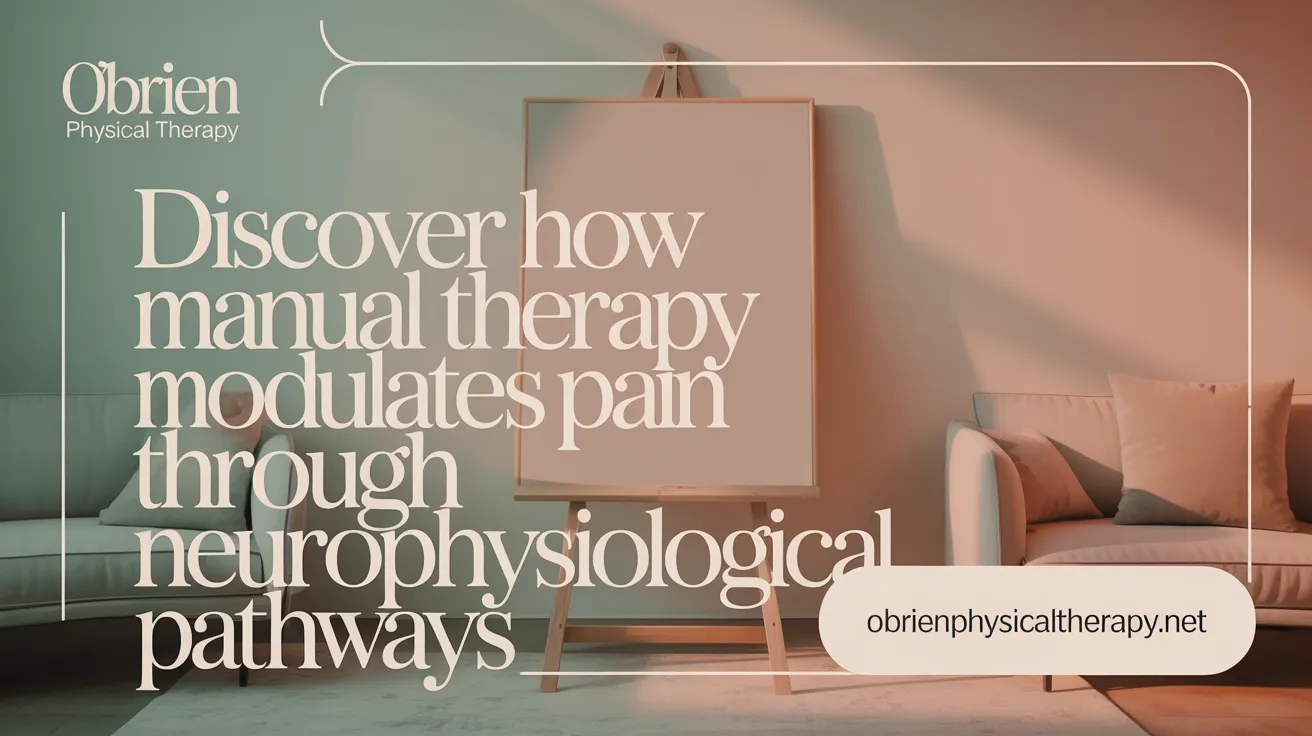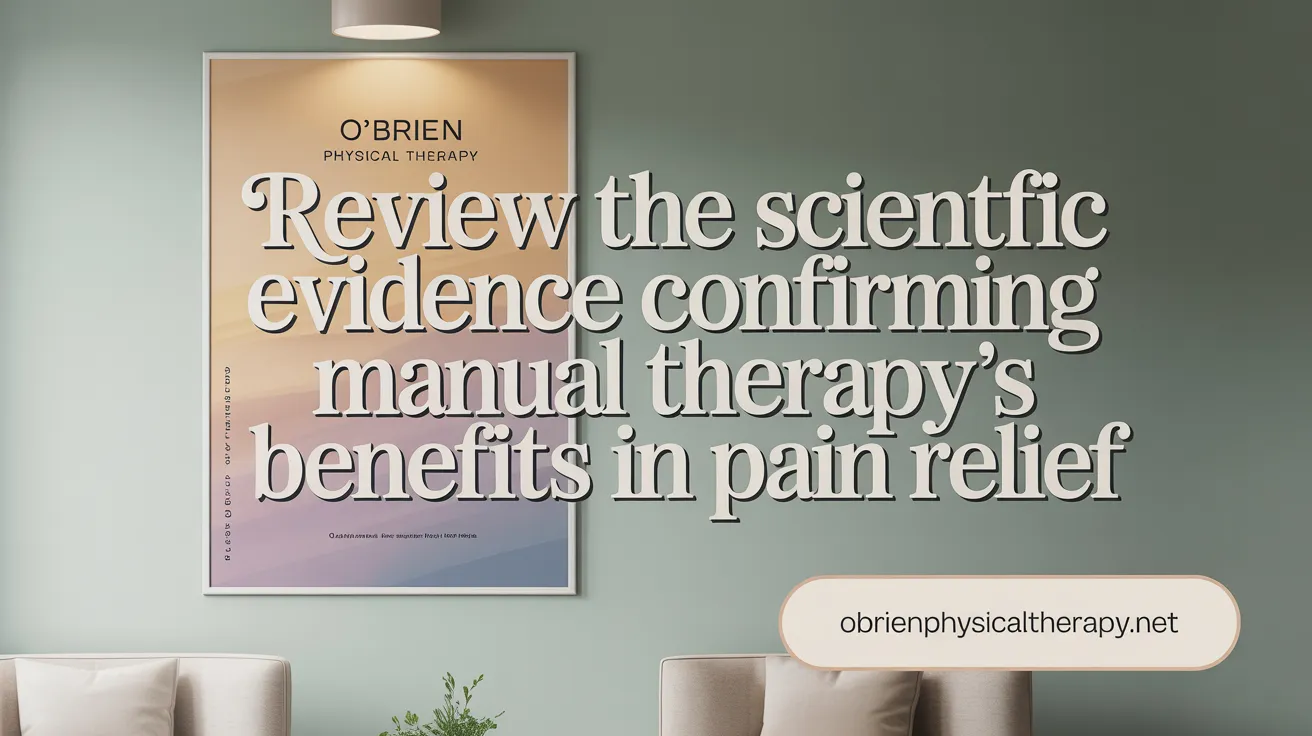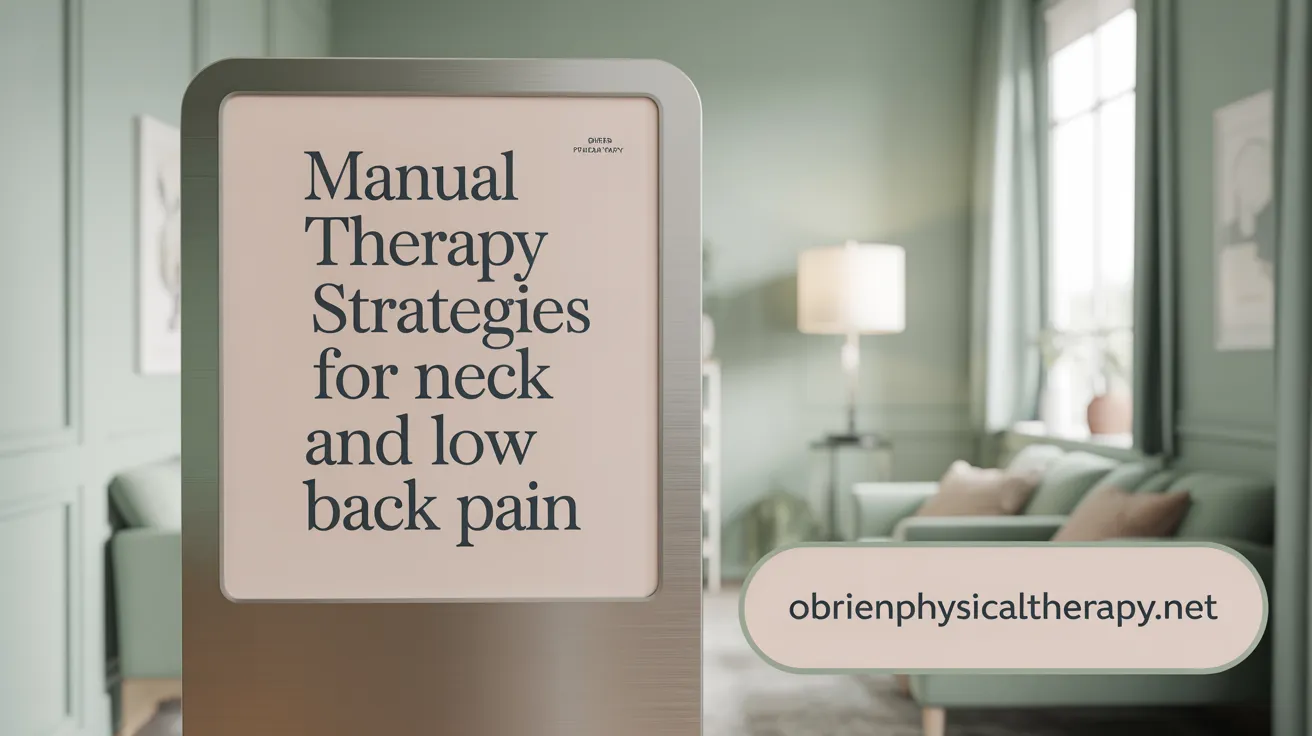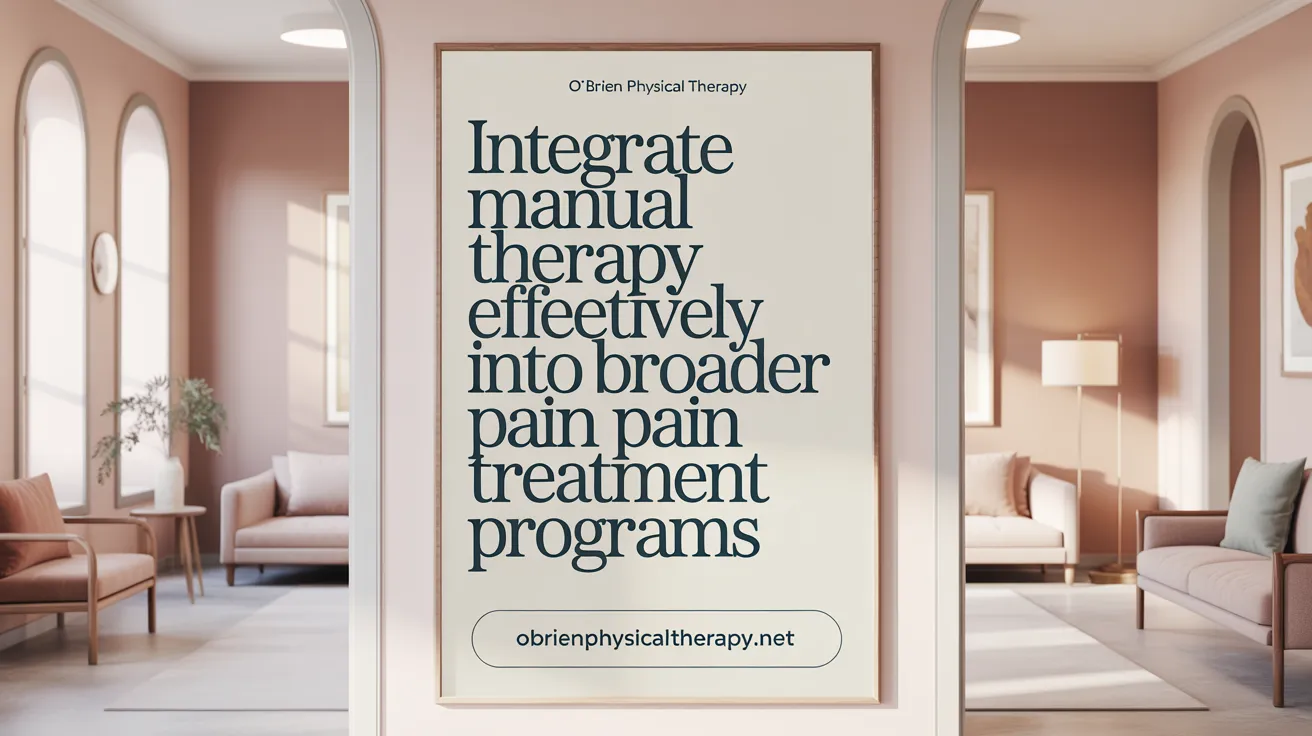The Therapeutic Touch: Manual Therapy in Pain Relief
Manual therapy has emerged as a cornerstone in the management of pain, especially musculoskeletal and chronic pain conditions. By utilizing skilled, hands-on techniques, physical therapists and other healthcare practitioners can directly influence the underlying causes of pain, improve function, and enhance patients' quality of life. This article explores the mechanisms, techniques, scientific support, and clinical applications of manual therapy in comprehensive pain relief and rehabilitation strategies.
Mechanisms Behind Manual Therapy’s Pain-Relieving Effects

What are the main mechanisms by which manual therapy contributes to pain relief?
Manual therapy (MT) alleviates pain primarily through neurophysiological mechanisms that target the nervous system across various levels. These include activating descending pain inhibitory pathways, which help suppress nociceptive signals before they reach the brain. During therapy, neurochemical mediators such as endogenous opioids, endorphins, and serotonin are released, further reducing pain perception.
In addition to neuropeptides, MT influences inflammatory cytokines, often decreasing levels of pro-inflammatory mediators that contribute to pain and tissue sensitivity. This neuroimmune response helps reduce neurogenic inflammation, alleviating soreness and swelling.
On a cortical level, MT causes changes in brain activity linked to pain processing, including decreased activity in key pain-related areas like the anterior cingulate cortex and insular cortex. Neuroimaging studies show that manual therapy can alter functional connectivity in networks implicated in pain perception.
While biomechanical effects such as tissue movement and structural changes are observed during manual interventions, they are generally transient and their direct involvement in pain relief is limited. The complex neurophysiological responses, however, play a pivotal role in mediating analgesic effects.
Psychological and contextual factors also influence outcomes. Expectations, therapeutic alliance, and psychological state can modulate the neurophysiological pathways, enhancing or diminishing pain relief. These effects underscore the importance of patient-practitioner interaction.
Overall, manual therapy’s efficacy appears rooted in its ability to manipulate neural pathways and neurochemical mediators involved in pain modulation. This integrated neurophysiological response, rather than biomechanical changes alone, predominantly underpins its pain-relieving benefits, although further research is needed to fully understand these mechanisms.
Diverse Manual Therapy Techniques and Their Applications
 Manual therapy employs a variety of hands-on physical therapy techniques designed to alleviate pain and enhance mobility. Among the most common methods are joint mobilization and manipulation, soft tissue mobilization, and myofascial release. Joint mobilization involves gently guiding affected joints through their range of motion to reduce stiffness and restore function, while high-velocity thrusts may be used to address chronic restrictions effectively.
Manual therapy employs a variety of hands-on physical therapy techniques designed to alleviate pain and enhance mobility. Among the most common methods are joint mobilization and manipulation, soft tissue mobilization, and myofascial release. Joint mobilization involves gently guiding affected joints through their range of motion to reduce stiffness and restore function, while high-velocity thrusts may be used to address chronic restrictions effectively.
Soft tissue techniques focus on muscles, tendons, ligaments, and fascia to relieve tension, break up scar tissue, and promote increased blood flow. Myofascial release, for example, applies sustained pressure to the fascia to decrease pain and stiffness.
Trigger point therapy targets tight knots in muscles that can cause localized and referred pain, releasing these points to improve comfort. Muscle energy techniques utilize gentle muscle contractions to lengthen shortened muscles and improve joint mobility, offering quick pain relief.
Several clinical frameworks guide manual therapy practice. The Maitland approach emphasizes graded mobilizations to control pain and improve movement, while Cyriax focuses on soft tissue lesion diagnosis with specific testing and treatment protocols. Other models include Kaltenborn-Evjenth (utilizing translatory joint movements) and Mulligan, which combines movement with passive correction.
Importantly, manual therapy is often integrated with patient education and exercise programs to optimize outcomes. Techniques are tailored to individual needs, considering the patient’s specific condition, history, and response. This holistic approach ensures that therapy addresses not just symptoms but also underlying causes, enhancing overall recovery and function.
In summary, manual therapy encompasses a spectrum of skillful, evidence-informed techniques. When combined with educational and active interventions, it forms a cornerstone of effective pain management and functional restoration, applicable across a wide range of neuromusculoskeletal conditions.
Scientific Evidence Supporting Manual Therapy's Effectiveness

What scientific evidence supports the effectiveness of manual therapy for pain relief?
Research-based evidence shows that manual therapy (MT) provides tangible benefits in reducing pain, especially in musculoskeletal conditions such as chronic low back pain, neck pain, and joint dysfunction. Multiple systematic reviews and meta-analyses reveal that MT can significantly decrease pain intensity and enhance physical function.
Neurophysiological studies demonstrate that MT influences the nervous system by decreasing inflammatory mediators like cytokines, reducing spinal excitability, and altering brain activity in pain-processing regions. These effects contribute to hypoalgesia, or pain relief, often lasting up to 24 hours. Imaging studies, including functional MRI, have shown that MT can reduce activity in cortical areas involved in pain perception and modify the connectivity of pain-related brain networks.
Beyond biomechanical effects, psychological factors play a substantial role in MT's success. Patient expectations, the therapeutic alliance, and context can enhance treatment outcomes. Evidence also indicates that MT decreases pain catastrophizing, lowering fear and anxiety associated with chronic pain.
However, the overall quality of existing evidence varies. While many studies support MT's benefits, they often have limitations such as small sample sizes and risk of bias. Despite this, current findings suggest that manual therapy, particularly when combined with exercises and education, can be a valuable component of comprehensive pain management strategies.
Overview of research findings:
| Evidence Aspect | Summary | Additional Details |
|---|---|---|
| Clinical research and systematic reviews | Support for pain reduction and functional improvement | Moderate to low quality evidence |
| Neurophysiological effects | Changes in brain activity, inflammatory markers, and pain pathways | Imaging and biomarker studies |
| Psychological and contextual factors | Enhanced effects with positive patient expectations and therapeutic alliance | Moderates treatment efficacy |
| Limitations and quality of evidence | Variability in study quality, small sample sizes, and inconsistent methodologies | Calls for further rigorous research |
Summing up
Current scientific investigations support the overall effectiveness of manual therapy in providing pain relief. Its benefits are mediated through neurophysiological pathways, biomechanical changes, and psychological influences. While more high-quality research is needed to refine understanding, manual therapy remains a well-supported option for managing various chronic pain conditions.
Manual Therapy’s Role Within Broader Physical Therapy and Pain Management Strategies
What role does manual therapy play within physical therapy and overall pain treatment strategies?
Manual therapy holds a significant position in modern physical therapy, serving as a versatile tool that addresses various aspects of musculoskeletal pain. It involves skilled, hands-on techniques such as joint mobilization, soft tissue manipulation, trigger point therapy, and myofascial release, all aimed at reducing pain, enhancing mobility, and promoting healing.
This approach doesn't work in isolation; instead, it is integrated into comprehensive treatment plans that include therapeutic exercises, patient education, and lifestyle modifications. By combining manual therapy with these strategies, clinicians can target both the physical and neurophysiological factors contributing to pain.
Scientific evidence supports the neurophysiological impacts of manual therapy, such as activation of endogenous pain-relief pathways and neuroimaging findings showing altered cortical activity in pain-processing brain regions. Immediate effects such as reduced muscle tension, improved joint movement, and decreased inflammation are often observed, which can serve as a foundation for longer-term recovery.
Manual therapy also influences psychological and contextual factors like patient expectations and therapeutic alliance, which can enhance treatment outcomes. Overall, its role is to modulate pain through biomechanical and neurophysiological pathways, making it a vital component within multimodal pain management programs.
How is manual therapy combined with exercise and education?
In practice, manual therapy is most effective when combined with active interventions such as tailored exercise programs and educational components that inform patients about pain mechanisms and self-management techniques. This triad fosters an empowering environment, encouraging patients to take an active role in their recovery.
Education about pain neuroscience and movement strategies helps address the complex, multidimensional nature of pain, particularly in chronic cases. Together, manual therapy and exercise form a cycle where manual techniques prepare tissues for movement, and exercises reinforce mobility, strength, and function.
The synergy between hands-on techniques and active participation accelerates clinical outcomes, enhances adherence, and supports sustainable health behaviors.
What are the short- and long-term benefits of manual therapy?
Short-term benefits include immediate pain relief, reduced muscle tension, improved joint mobility, and decreased inflammation. These effects can provide rapid symptom management, making subsequent therapies such as exercise or movement training more effective.
Long-term benefits include sustained improvements in mobility, muscle function, and overall pain reduction. Manual therapy helps break the cycle of pain, muscle guarding, and movement avoidance that often hampers recovery in chronic conditions.
Research indicates that when integrated into a broader treatment plan, manual therapy can decrease reliance on medications, prevent future injuries, and improve quality of life.
How does manual therapy fit into multidisciplinary pain management?
Manual therapy is a crucial element within multidisciplinary pain care approaches that combine physical therapy, psychological support, pharmacological management, and lifestyle interventions. It provides a non-invasive, drug-free option that can be tailored to individual patient needs.
Its ability to alleviate pain, restore function, and influence neurophysiological processes complements other modalities like patient education, cognitive-behavioral therapy, and mindfulness strategies. Together, these interventions address the complex biopsychosocial factors involved in pain, offering a holistic pathway to recovery.
In summary, manual therapy's integration within comprehensive treatment strategies enhances outcomes and supports the management of both acute and chronic pain conditions effectively.
Applying Manual Therapy to Specific Pain Conditions: Neck and Low Back Pain
 Manual therapy tailored to conditions like neck and low back pain involves a variety of hands-on techniques delivered by trained healthcare professionals such as physical therapists, chiropractors, or osteopaths.
Manual therapy tailored to conditions like neck and low back pain involves a variety of hands-on techniques delivered by trained healthcare professionals such as physical therapists, chiropractors, or osteopaths.
In cases of neck pain, particularly when it is non-specific, practitioners typically utilize cervical and thoracic joint mobilizations, gentle manipulations, and soft tissue massage. These interventions aim to reduce joint stiffness, alleviate muscle tension, and improve overall neck mobility.
For low back pain, manual therapy focuses on relieving tissue restrictions and addressing joint dysfunction. Techniques such as lumbar joint mobilization, soft tissue manipulation, and neural mobilization help increase blood flow, decrease muscle tightness, and promote healing.
Evidence supports the effectiveness of these interventions, showing they can provide significant pain relief and functional improvements. When combined with exercise and patient education within a comprehensive treatment plan, manual therapy can produce more durable, long-term benefits.
Clinicians carefully assess each patient’s condition and tailor interventions to individual needs, considering specific tissue sensitivities and movement limitations. This personalized approach enhances treatment efficacy.
Current guidelines recommend manual therapy as a safe and effective treatment component for neck and low back pain. Despite some transient mild effects, adverse events are generally uncommon and mild.
Overall, applying manual therapy with an evidence-based, patient-centered framework ensures optimal outcomes, helping patients regain function, reduce pain, and improve quality of life.
Integrating Manual Therapy into Comprehensive Pain Management Plans
 Manual therapy techniques, such as joint mobilization, soft tissue manipulation, myofascial release, and neurophysiological strategies, play a vital role when incorporated into multifaceted pain management approaches. These hands-on interventions are most effective when combined with patient education, movement re-education, and psychological support, creating a holistic treatment plan tailored to individual needs.
Manual therapy techniques, such as joint mobilization, soft tissue manipulation, myofascial release, and neurophysiological strategies, play a vital role when incorporated into multifaceted pain management approaches. These hands-on interventions are most effective when combined with patient education, movement re-education, and psychological support, creating a holistic treatment plan tailored to individual needs.
Understanding the mechanisms of manual therapy—encompassing biomechanical effects, neurochemical modulation, and patient-specific factors—enables clinicians to adapt treatments to different pain mechanisms, including nociceptive, nociplastic, or neuropathic pain. For example, neurophysiological effects like reduced inflammatory markers or altered cortical activity can be enhanced through personalized interventions.
In practice, manual therapy is integrated as an adjunct to other modalities such as therapeutic exercises, behavioral therapies, and medical management. This multimodal approach not only addresses the physical contributors to pain but also considers psychological and social factors, thereby improving overall outcomes.
Furthermore, fostering a strong therapeutic alliance and managing patient expectations are crucial. The clinician’s communication, empathy, and shared decision-making enhance the patient's engagement and response to treatment.
Ongoing assessment and regular re-evaluation guide necessary modifications to the plan, ensuring interventions remain aligned with the patient’s evolving needs. Including education about pain neuroscience and self-management strategies empowers patients, leading to better adherence and long-term results.
Overall, integrating manual therapy within a comprehensive, biopsychosocial framework supports reduced pain perception, enhanced mobility, and sustained functional improvements, significantly contributing to improved quality of life for individuals with chronic pain.
The Future of Manual Therapy in Pain Relief and Rehabilitation
Manual therapy stands as a vital, evidence-supported approach to managing pain and enhancing recovery in musculoskeletal and chronic pain conditions. Its multifaceted mechanisms, from neurophysiological modulation to biomechanical influence, underlie its analgesic effects and functional benefits. Integrating manual therapy within broader physical therapy and multidisciplinary pain management strategies maximizes patient outcomes by combining hands-on techniques with exercise, education, and psychological support. Ongoing research and refined clinical reasoning continue to evolve manual therapy practices toward more personalized, mechanism-based treatments. Ultimately, manual therapy offers a non-invasive, patient-centered pathway that not only alleviates pain but also fosters improved mobility, function, and quality of life.
